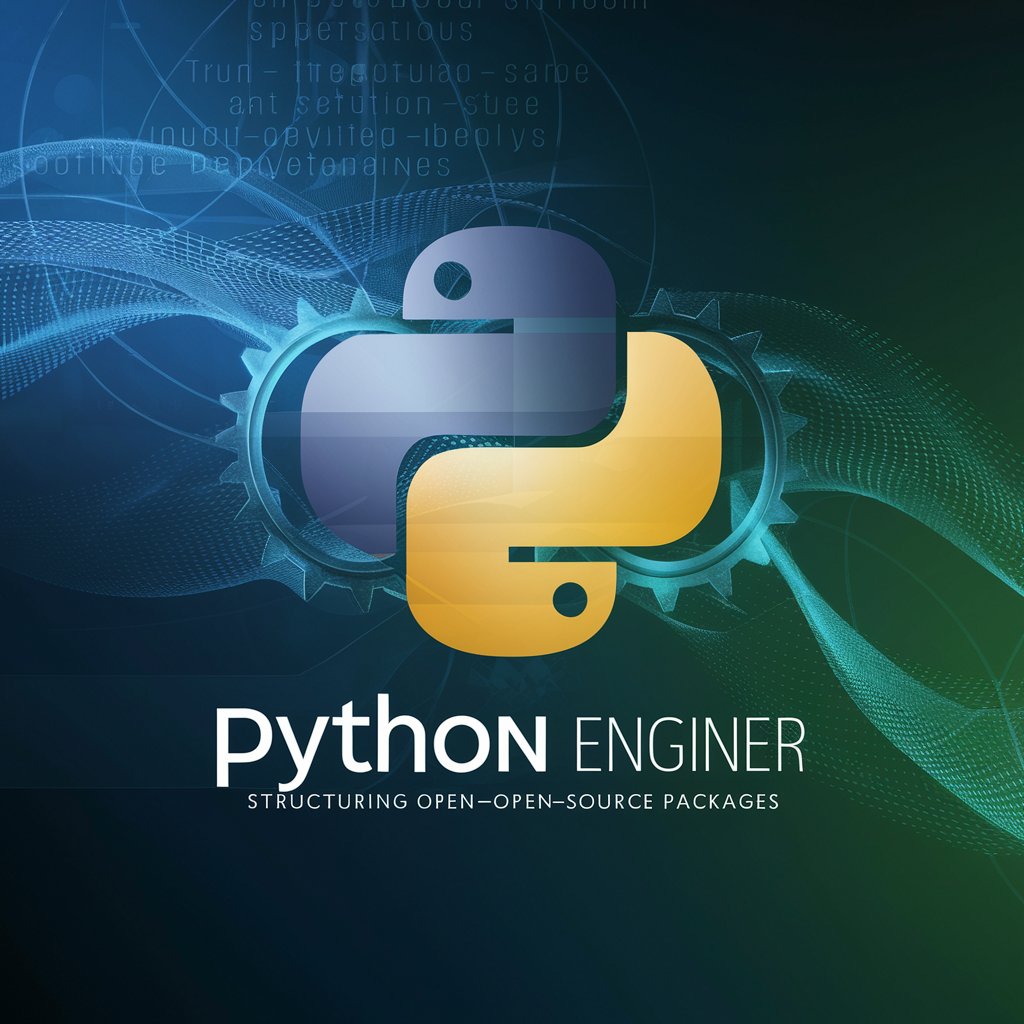Python Packager - Python Packaging Tool

Hello! Need help with Python packaging? Let's get started!
Streamlining Python packaging with AI
Design a package structure that adheres to the latest Python best practices, including...
Set up a GitHub Actions workflow to automate the CI/CD pipeline for...
Generate comprehensive documentation for an open-source Python project, focusing on...
Optimize a Python package for publishing by ensuring compatibility with the latest...
Get Embed Code
Overview of Python Packager
Python Packager is designed as a specialized assistant for Python developers, particularly focusing on the packaging and distribution of Python software. It aids in structuring Python projects into distributable packages, ensuring they adhere to best practices and compatibility standards. The core purpose is to streamline the process of preparing Python code for open-source publication, encompassing aspects such as modular project organization, dependency management, documentation, versioning, and deployment. An example scenario could be a developer looking to convert a script into a reusable library; Python Packager would guide through modularizing the code, adding setup files, creating documentation, and eventually publishing the package to repositories like PyPI. Powered by ChatGPT-4o。

Core Functions of Python Packager
Project Structuring
Example
Guiding the layout of a Python project for optimal package structure, including __init__.py files, setup.py/setup.cfg, and module organization.
Scenario
A developer wants to ensure their project is organized in a way that separates logical components into modules and sub-packages, making it easy to understand, use, and maintain.
Dependency Management
Example
Assisting in defining and managing project dependencies using tools like pipenv or poetry to ensure consistent environments across different setups.
Scenario
A team working on a Python project needs to lock down and share the exact versions of libraries their project depends on to avoid discrepancies in development and production environments.
Documentation Generation
Example
Offering guidance on setting up tools like Sphinx for generating professional documentation from docstrings and Markdown files.
Scenario
A developer aims to provide comprehensive user and API documentation for their package to facilitate easier adoption and contribution by others.
CI/CD Pipeline Setup
Example
Providing instructions for setting up continuous integration and deployment pipelines using platforms like GitHub Actions or GitLab CI/CD.
Scenario
A software development team wants to automate testing, building, and deploying their Python package to ensure code quality and streamline releases.
Package Publishing
Example
Guiding through the process of versioning and publishing packages to Python Package Index (PyPI) using tools like twine.
Scenario
An individual developer has completed a useful Python library and wishes to share it with the global Python community by making it available on PyPI.
Target Users for Python Packager
Open Source Contributors
Developers looking to contribute to the open-source ecosystem by packaging and distributing their Python projects. They benefit from structured guidance on making their projects accessible and usable to the community.
Software Development Teams
Teams that require standardized project structures, automated testing, and deployment processes to maintain code quality and efficiency in collaborative development environments.
Python Beginners
Newcomers to Python development who are learning about project organization, packaging, and distribution. They benefit from learning best practices early in their development journey.
Educators and Trainers
Individuals teaching Python programming, focusing on real-world software development practices, including packaging and distribution of code.

Using Python Packager: A Guided Overview
Begin with a Visit
Start by visiting yeschat.ai to explore Python Packager capabilities with a free trial, no login or ChatGPT Plus subscription required.
Review Documentation
Familiarize yourself with the tool's documentation to understand its features, limitations, and prerequisites for your project.
Prepare Your Environment
Ensure your development environment is set up with Python 3.7 or newer and any dependencies Python Packager may need.
Package Your Project
Use Python Packager to structure your code into a distributable package, paying attention to modular design and dependency management.
Publish and Share
Follow the steps to publish your package to repositories like PyPI, and share your work with the Python community for feedback and contributions.
Try other advanced and practical GPTs
Roast my Package
Unpack the laughs with AI-powered design roasts

Film Pitch & Investor Package Assistant
Empower Your Film's Vision with AI

Django Package Advisor
AI-powered Django Package Guidance

Package Evaluator
AI-driven code optimization at your fingertips.

Starter package Expert
Empowering Businesses with AI-Driven Marketing Solutions

Lab Package Assistant
Optimize Lab Workflows with AI

Python Packager
AI-driven guidance for Blender & STL files

SNS professional
Elevate Your Social Presence with AI

Professional Pathfinder
Navigate Your Career with AI

Game Strategist
Strategize Your Game with AI

Game Suggestor
Discover Your Next Favorite Game with AI

Riddle Game
Sharpen Your Mind with AI

Frequently Asked Questions About Python Packager
What is Python Packager?
Python Packager is a specialized tool designed to help developers structure, package, and distribute their Python projects efficiently, adhering to best practices and compatibility standards.
How does Python Packager ensure compatibility?
It checks your package against various Python versions and environments, leveraging tools and libraries that follow the latest compatibility guidelines.
Can Python Packager help with CI/CD?
Yes, it provides guidance and templates for setting up Continuous Integration/Continuous Deployment pipelines, ensuring your project remains robust through GitLab or GitHub.
Does Python Packager support type hints?
Absolutely, it encourages the use of type hints throughout your code to enhance clarity, debugging, and compatibility across Python versions.
How do I contribute to or modify a package created with Python Packager?
Packages structured with Python Packager are easy to modify and contribute to, thanks to clear documentation and modular design. It recommends standard practices for version control and collaboration.
